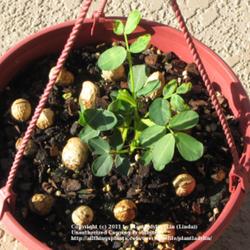
Surprising though it may be, the peanut is a vegetable and not a nut. It doesn't grow on trees. It isn't harvested above ground. Instead, peanut pegs (where the nuts form on the peanut plant) develop on the base of spent flowers and bury themselves in the ground. To harvest the peanuts, you dig up the plants. A member of the legume family, gardeners can reap this energy-packed vegetable as far north as Ontario, Canada.
The Origins of PeanutsBecause peanut-shaped pottery jars were uncovered in Peruvian Inca tombs, it's believed that peanuts originated in Brazil or Peru as early as 950 B.C. Similar artifacts found in Bolivia and Argentina indicate that peanuts were treasured there, too.
When the Spanish Conquistadors traveled to South America in search of gold, they returned to their native land bearing peanuts as their prize, and the legume became one of Spain's prime crops.
The Spaniards traded peanuts to Africans for elephant tusks and spices. The Africans called this strange-looking food "goobers" and believed that the peanut plant possessed a soul.
Peanuts in North AmericaPeanuts, also known as earth nuts, earth almonds, groundnuts, pendars, monkey nuts, or manilla nuts, first came to North America during the 18th century. Slave traders bought them from Africans as the cheapest, easiest, on-board food for slaves.
Until the late 1800s, peanuts were grown in this country principally for fattening farm animals. Since that time, the peanut has grown both in popularity and profitability. Through extensive research, Dr. George Washington Carver found peanuts to be an abundant source of fats, proteins and other nutrients. His pioneering creativity led to the development of more than 300 uses for the peanut. These include axle grease, linoleum, wood stains, shaving cream, paper, ink, adhesives, plastics, fertilizer and wallboard. All parts of the peanut -- the shell, nutmeat and plant -- have diversified uses, and they may each be incorporated in a variety of food products, including chile sauce, cheese, mayonnaise, milk and candy.
Peanut ButterOne product that most of us keep on hand is peanut butter. This popular spread was created in the late 1800s by a St. Louis physician, who had been searching for a nutritious, easy-to-digest food for elderly patients.
Around the turn of this century, housewives found a new gadget on the market -- a small, money-saving hand device they could use in their own kitchens to make peanut butter. A few years later, owners of small country stores were using this same invention to make their own peanut butter, and selling it from large, wooden tubs.
Today, at least 200,000 tons of peanut butter are consumed yearly in the United States. One pound of peanuts provides the approximate energy value of 1 pound of beef, 1 1/2 pounds of cheddar cheese, 9 pints of milk or 3 dozen medium eggs.
Although commercial peanut production in the United States is concentrated in Texas, Oklahoma, Virginia, North Carolina, Georgia, Alabama and Florida, most people can successfully grow peanuts in their home gardens, throughout the U.S.
 Victory Seed Company has all the seeds you want for your best garden in 2024.
Victory Seed Company has all the seeds you want for your best garden in 2024.
For 25 years, the family-owned Victory Seed Company has provided the highest quality vegetable, herb and flower seeds to families across the country. We are passionate about providing you the best seeds available that give excellent germination, robust plants, and the harvest you want. With a catalog of over a thousand varieties, we have everything, and our prices are the kinds that we'd want to pay. We have hundreds of yesterday's heirloom vegetables, as well as today's award winning hybrid selections. Get to know us by visiting our website and browsing through our online vegetable seed catalog.
| 1. Preparing to Plant Peas |
| 2. Choosing Pea Varieties |
| 3. Perfecting Your Soil for Peas |
| 4. Growing Peas in Raised Beds |
| 5. About Peanuts ← you're on this article right now |
| 6. How Peanuts Grow |
| 7. Planting Preparation for Peanuts |
| 8. Pea Essentials |
| 1. Preparing to Plant Peas |
| 2. Choosing Pea Varieties |
| 3. Perfecting Your Soil for Peas |
| 4. Growing Peas in Raised Beds |
| 5. About Peanuts ← you're on this article right now |
| 6. How Peanuts Grow |
| 7. Planting Preparation for Peanuts |
| 8. Pea Essentials |